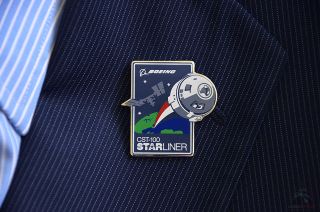First Look: Boeing CST-100 Starliner Crew Spacecraft Program Patch

First it was given an acronym, then it was assigned a name. Now Boeing's CST-100 Starliner crewed spacecraft has its own program patch.
The commercial space capsule, which Boeing is producing to transport NASA astronauts to and from the International Space Station, features prominently on the new logo.
The rectangular insignia, which replaces a circular emblem that was used before the Boeing crew space transportation (CST) system was formally christened in September 2015, now includes the Starliner moniker. [CST-100: Images of Boeing's Private Space Capsule]
On the new patch, the Starliner spacecraft protrudes from the right side of the insignia, trailing the red, white and blue banner from NASA's Commercial Crew Program logo. On the opposite side of the Boeing patch, also extending from the border, is the space station orbiting above the Earth.
Three stars above the planet memorialize three astronauts — Virgil "Gus" Grissom, Edward White and Roger Chaffee — who died in a 1967 fire during a test on the launch pad. The stars are also meant to represent the three U.S. space tragedies, Apollo 1, Challenger and Columbia.
The Starliner is the sixth piloted space vehicle that Boeing and its lineage of companies has developed and built. The aerospace giant's spaceflight heritage began with NASA's Mercury spacecraft and the Air Force's X-15 rocket plane, and extends through NASA's Gemini and Apollo capsules and the space shuttle orbiters.
This year marks Boeing's centennial, having been founded on July 15, 1916.
Get the Space.com Newsletter
Breaking space news, the latest updates on rocket launches, skywatching events and more!
"The CST-100 [Starliner] incorporates 50 years of heritage in spacecraft design, and is paving the way for the next 100 years of flight," said Chris Ferguson, Boeing's director of crew and mission operations for the CST-100 Starliner and the commander of NASA's final space shuttle mission, at the Starliner's naming ceremony.

In September 2014, NASA chose Boeing and SpaceX to provide launch services for its space station-bound crews. The space agency awarded a total of $6.8 billion, including $4.2 billion to Boeing for it complete and certify the CST-100 Starliner for flight and $2.6 billion for SpaceX to do the same with its Crew Dragon capsule.
In 2015, NASA ordered its first two Starliner missions, to follow Boeing's planned uncrewed and crewed test flights to the space station. Boeing's first piloted test, targeted for late 2017, will be crewed by a NASA astronaut and Boeing test pilot, who have yet to be assigned.
The Starliner's missions will launch with four space station expedition crew members, including NASA astronauts and their international crewmates. The capsules will lift off atop Atlas V rockets from the Cape Canaveral Air Force Station in Florida.
At the end of its mission, the CST-100 Starliner will return to Earth under parachutes and deploy airbags to cushion a touchdown on land in the desert plains of the southwestern United States.
See the art for Boeing's new CST-100 Starliner spacecraft program patch at collectSPACE.
Follow collectSPACE.com on Facebook and on Twitter at @collectSPACE. Copyright 2016 collectSPACE.com. All rights reserved.
Join our Space Forums to keep talking space on the latest missions, night sky and more! And if you have a news tip, correction or comment, let us know at: community@space.com.

Robert Pearlman is a space historian, journalist and the founder and editor of collectSPACE.com, an online publication and community devoted to space history with a particular focus on how and where space exploration intersects with pop culture. Pearlman is also a contributing writer for Space.com and co-author of "Space Stations: The Art, Science, and Reality of Working in Space” published by Smithsonian Books in 2018. He previously developed online content for the National Space Society and Apollo 11 moonwalker Buzz Aldrin, helped establish the space tourism company Space Adventures and currently serves on the History Committee of the American Astronautical Society, the advisory committee for The Mars Generation and leadership board of For All Moonkind. In 2009, he was inducted into the U.S. Space Camp Hall of Fame in Huntsville, Alabama. In 2021, he was honored by the American Astronautical Society with the Ordway Award for Sustained Excellence in Spaceflight History.

